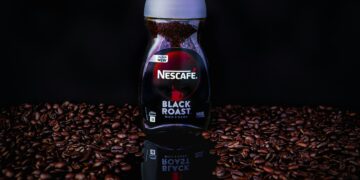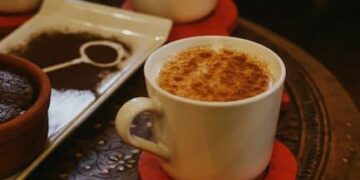Table of Contents
My name is Alex, and for years, I waged a quiet, frustrating war in my own kitchen.
It was a war against the watery, acrid, and soul-crushingly disappointing homemade iced latte.
Like many of you, I’d fallen in love with the rich, creamy, and invigorating iced lattes from my favorite local cafés.
I was spending a small fortune on them.1
Convinced I could replicate the experience at home, I invested.
I bought a respectable espresso machine, a burr grinder, and, most importantly, the good coffee.
My first major campaign in this war involved a bag of single-origin Guatemalan beans.
The tasting notes promised a symphony of chocolate and caramel—flavors I knew would be divine when chilled.2
I followed the online recipes meticulously.
The steps seemed simple enough: brew espresso, get some milk, pour it all over i.e.3
The result? A tragedy in a glass.
The beautiful chocolate notes were gone, replaced by a harsh, bitter bite.
The drink was thin, watery, and tasted nothing like the beans’ description or the café’s creation.
It was a failure that felt personal.
I had followed the rules, yet here I was, with a cup of expensive disappointment.
This failure sent me down a rabbit hole, a desperate search for the secret I was clearly missing.
What I found was a bewildering storm of conflicting advice.
The Chaos of Contradiction: Why “Standard Advice” Fails
The deeper I dug, the more confusing it became.
The internet, it turned out, was a battlefield of warring iced latte ideologies.
Barista forums and recipe blogs were filled with passionate, yet completely contradictory, instructions on the “correct” order of operations.
- One camp, the “Ice-First Purists,” insisted you must fill the glass with ice, then milk, and finally pour the hot espresso on top for a beautiful layered effect.5
- Directly opposing them were the “Milk-First Methodists.” They argued that pouring hot espresso directly onto ice was a cardinal sin. You had to pour the milk in first to act as a buffer.7
- A third faction, the “Off-Site Assemblers,” dismissed both methods. They advocated for mixing the espresso, milk, and any syrups in a separate pitcher or shaker before pouring the entire concoction over ice.8
Who was right? Following one person’s “perfect” recipe meant directly violating another’s sacred rule.
It was chaos.
This wasn’t a simple matter of preference; it was a fundamental disagreement about process.
Trying to navigate this landscape felt like trying to assemble furniture with three different sets of instructions—none of which seemed to work.
Through the noise, however, I started hearing whispers of a common enemy, a mysterious villain responsible for my bitter failures: “espresso shock.” The term, sometimes called “scorching,” described what happens when piping-hot espresso collides with i.e. Proponents of the milk-first method claimed this violent temperature change “burned” the espresso, making it taste watery and over-extracted.7
This gave a name to my problem, but it didn’t offer a real solution.
It felt like barista folklore, an urban myth with no scientific backing.
Why would a rapid temperature change ruin coffee? And if it did, what was the
right way to prevent it?
An Epiphany from the Forge: The Blacksmith’s Secret to Perfect Coffee
My obsession led me far beyond the world of coffee.
I started reading about thermal dynamics in other fields, from industrial manufacturing to materials science.
And that’s when I found it—the key that would unlock everything.
It wasn’t in a coffee blog or a barista manual; it was in a technical paper about metallurgy.
The paper described the ancient art of making a sword.
When a blacksmith forges a blade, they heat the steel until it’s glowing red and then plunge it into water or oil.
This process, called quenching, makes the steel incredibly hard.
But it also introduces a fatal flaw: the steel becomes brittle.
A quenched-but-untempered blade is so fragile it can shatter like glass upon impact.12
Its hardness is useless without strength.
To solve this, the blacksmith performs a second, crucial step: tempering.
They gently and precisely reheat the brittle blade to a specific, much lower temperature.
This controlled heating allows the internal crystal structure of the steel to relax and realign, relieving the stress created by the violent quench.
The blade is then cooled gradually.
The result is a material that is not only hard but also tough and flexible—able to bend without breaking, to hold an edge, and to withstand the shock of battle.13
Reading this, the lightbulb didn’t just go on; it exploded.
I wasn’t just making bad iced lattes.
I was quenching my espresso.
I was taking this delicate, complex liquid, fresh from the machine at nearly 200°F, and subjecting it to a violent thermal shock by dumping it onto i.e. I was creating a brittle, shattered flavor profile.
The harsh acidity, the watery body, the bitter aftertaste—these were the sensory shards of a “shocked” espresso.
The solution wasn’t just to cool the espresso down.
The solution was to temper it.
From Recipe to Process: The Tempering Framework Explained
This realization changed everything.
I stopped thinking about making an iced latte as a simple recipe and started thinking of it as a process of thermal management.
The goal is not merely to cool the espresso but to acclimatize it to the cold.16
This means guiding it down the temperature gradient in a controlled, staged manner to protect its delicate structure and flavor.
The barista folklore was right, even if they didn’t have the language of metallurgy to explain it.
“Espresso shock” is a very real, scientifically observable phenomenon.
When you pour hot espresso directly over ice, you trigger a cascade of destructive events.
The Science of “Espresso Shock”
An espresso shot is a marvel of chemistry.
It’s a supersaturated solution and a complex emulsion of oils, acids, sugars, and hundreds of volatile aromatic compounds (VOCs) extracted from the bean under heat and pressure.18
These components exist in a delicate, temporary balance.
A sudden, violent temperature drop—a thermal shock—shatters that balance.
- Volatile Compound Degradation: The beautiful aromas of coffee—the floral, fruity, and nutty notes—are carried by highly volatile compounds.20 These compounds are fragile and escape easily. When hot espresso hits ice, the extreme temperature difference causes these delicate aromatics to flash off and dissipate into the air almost instantly. Furthermore, rapid cooling can halt or alter chemical reactions that are still occurring post-brew, leading to the degradation of key flavor molecules like 2-furfurylthiol, which is associated with a fresh coffee aroma.20 The result is a “duller” coffee that has lost its aromatic complexity.
- Breaking the Emulsion: The rich body and creamy mouthfeel of a great espresso come from its oils, which are emulsified in the water.22 Like a vinaigrette dressing, this emulsion is unstable. A rapid temperature shock can cause these oils to break out of the emulsion, coagulating and solidifying into a waxy, unpleasant film.11 This is what leads to that thin, watery body and sometimes an oily, bitter taste on the palate.
- Accentuating Acidity: Coffee contains various acids, most notably chlorogenic acids. When coffee is hot, its sweetness and rich aromas balance out the perception of these acids. However, as coffee cools, our ability to perceive sweetness diminishes while our perception of acidity can increase.11 A rapid shock-cooling seems to amplify this effect, making the sour notes of the acids unpleasantly sharp and prominent, a phenomenon Randy Anderson of Cold Brew Consulting notes when he explains that slowly chilling hot espresso leads to an over-development of quinic acid, which tastes astringent.23
The chaotic debate among baristas suddenly made perfect sense.
It wasn’t arbitrary; it was an intuitive, collective struggle to solve the problem of thermal shock.
The “milk-first” and “mix-in-pitcher” camps were, without knowing it, advocating for tempering.
They were introducing a buffer to soften the thermal blow.
This leads to the most crucial understanding: Making a great iced latte is not a recipe problem; it is a process control problem. It is about managing the thermal journey of the espresso from hot to cold.
Once you understand the why—the principle of tempering—you are no longer a recipe-follower.
You become a craftsperson, able to adapt, troubleshoot, and perfect your drink every single time.
Pillar 1: Forging the Foundation – Selecting Your “Steel” (The Coffee)
Just as a blacksmith chooses the right steel for a blade, the foundation of a tempered iced latte is selecting the right coffee and brewing it for strength.
Not all beans are created equal when it comes to standing up to milk and cold.
The Right Roast for the Job
For an iced latte, you need a coffee that can “cut through” the cold and the creaminess of the milk.
This is where roast level becomes critical.
- Medium to Dark Roasts: These are the ideal choice. The longer roasting process develops deeper, more robust flavors like chocolate, caramel, and nuts, while reducing the coffee’s bright, sharp acidity.25 These are the exact flavors that shine when chilled and paired with milk. A well-developed medium-dark roast provides the backbone your latte needs to avoid tasting weak or muted.2
- Light Roasts: While prized for their delicate, floral, and acidic notes in hot pour-overs, light roasts often get lost in an iced latte. Their subtle flavors can be overwhelmed by the milk, and their higher acidity can taste unpleasantly sour when cold, sometimes even clashing with the dairy to create a “curdled” taste perception.25
Origin Matters: Finding Your Flavor Profile
Certain coffee-growing regions are renowned for producing beans with profiles perfectly suited for iced drinks.
Look for beans from:
- Guatemala: Often exhibits a perfect balance of rich chocolate notes and bright, clean acidity, creating a naturally sweet and complex base that requires little to no extra sweetener.2
- Brazil: Known for a nutty, chocolatey profile with low acidity, making for an exceptionally smooth and approachable iced latte.2
- Colombia: Colombian Supremo beans offer excellent balance with classic caramel and chocolate undertones that hold up beautifully in cold, milk-based drinks.2
Brew for Strength
An iced latte will always have some dilution from melting ice, even when using the tempering method.
To counteract this, you must start with a more concentrated coffee base than you would for a hot drink.25
- For Espresso: Aim for a slightly “ristretto” style shot, which means using the same amount of ground coffee but less water. A common ratio for a standard double shot is 1:2 (e.g., 18g of coffee grounds to 36g of liquid espresso). For an iced latte, tightening this to a 1:1.5 ratio (18g grounds to 27g liquid) will create a more intense shot that retains its character.30
- For Non-Espresso Methods: If you don’t have an espresso machine, you can still make a fantastic iced latte. The key is concentration. Use an AeroPress, Moka pot, or even a standard drip coffee maker, but adjust your coffee-to-water ratio to be about twice as strong as normal.4
| Table 1: Recommended Coffee Beans for Iced Lattes | |||
| Roast Level | Origin/Blend | Key Flavor Notes (When Iced) | Recommended For |
| Medium Roast | Guatemalan Antigua | Milk Chocolate, Toffee, Bright Sweetness | A balanced, classic latte with complexity.2 |
| Medium-Dark Roast | Brazilian Santos | Roasted Nuts, Dark Chocolate, Creamy Body | An exceptionally smooth, low-acidity, and comforting latte.2 |
| Dark Roast | Peet’s Major Dickason’s Blend | Rich, Earthy, Spicy, Full-Bodied | A bold, intense latte for those who want a strong coffee flavor to dominate.33 |
| Dark Roast | Italian or French Roast Blends | Smoky, Deeply Caramelized, Bold | A classic, robust “chef’s kiss” latte that stands up perfectly to milk and sweeteners.25 |
Pillar 2: The Quench – Mastering the Thermal Gradient
This pillar is the heart of the tempering process.
It’s where we manage the espresso’s descent from hot to cold, using milk, ice, and even a simple spoon as our tools of thermal control.
Milk: Your Essential Thermal Buffer
Cold milk is the most important tool in your tempering arsenal.
It serves as the gentle, first-stage coolant.
By introducing the hot espresso to a larger volume of cold milk before it ever sees ice, you drastically lower the temperature differential.
The milk absorbs the initial, most violent wave of heat, bringing the mixture to a much more manageable temperature.7
This single step is what prevents the volatile compounds from flashing off and the emulsion from breaking.
Furthermore, the fat content in the milk is crucial for the final drink’s texture.
Whole milk provides the richest, creamiest mouthfeel because its higher fat content froths better and adds more body.4
Oat milk is a fantastic non-dairy alternative known for its creamy texture.4
The Unsung Hero: The Right Ice
Not all ice is created equal.
The rate at which ice melts is a function of its surface-area-to-volume ratio.
- Large, Dense Cubes: These are your best friends. A single, large cube (or a few jumbo cubes) has much less surface area relative to its volume compared to a handful of small, cloudy ice cubes from a standard freezer tray. This means they melt significantly slower, chilling your drink effectively while minimizing dilution.1 Investing in a silicone mold for large cubes is one of the easiest ways to upgrade your entire iced drink game.
- Coffee Ice Cubes: An advanced technique is to freeze leftover coffee in an ice cube tray. Using these cubes ensures zero water dilution. However, be aware that as they melt, they will make your drink stronger, potentially altering the flavor balance you initially created.4
The Metal Spoon Trick: A Simple Boost
This simple hack, popular on social media, has real science behind it.
Before pouring your coffee, place a metal spoon in your glass of i.e. Metal is an excellent thermal conductor.
When you pour the liquid in, the spoon acts like a heat sink, drawing thermal energy out of the liquid and conducting it up the handle and into the air.37
This takes some of the thermal load off the ice, causing it to melt even more slowly.
It’s a small but perceptible boost to the tempering process.
| Table 2: The Science of Cooling: Shock vs. Tempering | ||||
| Method | Initial Temperature Gradient | Impact on Volatiles | Impact on Emulsion | Resulting Flavor Profile |
| Espresso on Ice (Shock) | Extreme (e.g., 195°F coffee on 32°F ice) | High loss of delicate aromatics due to rapid dissipation. | High risk of breaking the emulsion, leading to oil separation. | Harsh, sharp acidity; thin, watery body; bitter, often “burnt” or “scorched” taste.7 |
| Espresso into Milk (Temper) | Moderate (e.g., 195°F coffee into 40°F milk) | Preservation of volatile compounds. | Emulsion is stabilized and protected by the milk buffer. | Smooth, balanced acidity; rich, creamy body; integrated, complex coffee flavor.24 |
Pillar 3: The Art of Assembly – The Step-by-Step Tempered Iced Latte
With the principles understood, we can now assemble our masterpiece.
This is the master workflow, a sequence designed for maximum flavor preservation and texture.
Step 1: The Pre-Chill
Place your serving glass—preferably one that is sturdy and can handle temperature changes, like a Schott Tritan or a thick-walled tumbler—in the freezer for 5-10 minutes.40 Brewing espresso into a pre-chilled glass is the very first stage of our gradual cooling process.
It helps to gently siphon off the initial blast of heat.
Step 2: Brew Espresso & Integrate Sweetener
Brew your double shot of high-quality, strongly-brewed espresso.
Now for a critical step that trips up many beginners: if you are using any sweetener, especially a thick syrup like caramel or a solid sugar like brown sugar, you must add it to the hot espresso now.10 Stir vigorously until it is completely dissolved.
Heat is essential for proper molecular integration.
Adding syrup to a cold liquid will cause it to seize up and sink to the bottom as a stubborn, gloopy mess.8
Step 3: The First Temper (Milk)
In a separate container—a milk frothing pitcher, a cocktail shaker, or even just another large glass—pour your cold milk of choice.
Now, pour your hot espresso-and-sweetener mixture directly into the cold milk.
Immediately stir or swirl the mixture to fully incorporate it.
You will see the color instantly change to a uniform, creamy brown.
This is the moment of tempering.
You have successfully navigated the most dangerous part of the thermal journey, protecting the espresso’s delicate soul.
Step 4: The Final Quench (Ice)
Take your pre-chilled serving glass from the freezer.
Fill it to the brim with your large, dense ice cubes.
Now, simply pour the tempered coffee-and-milk mixture from your pitcher over the i.e. The temperature difference is now gentle, the ice will melt slowly, and the flavor will be perfectly preserved.
Give it a final stir, and enjoy.
| Table 3: The Perfect Iced Latte Ratio Card | |||
| Drink Size | Espresso | Milk | Sweetener (Optional) |
| Small / Tall (12 oz) | 1 double shot (~2 oz) | ~6-7 oz | 1-2 tbsp (or 2 pumps) syrup 41 |
| Medium / Grande (16 oz) | 2 double shots (~4 oz) | ~8 oz | 2-3 tbsp (or 3-4 pumps) syrup 4 |
| Large / Venti (20-24 oz) | 3 double shots (~6 oz) | ~8-10 oz | 4 tbsp (or 5-6 pumps) syrup 41 |
| Note: These are starting points. Adjust milk volume based on the amount of ice used to fill your specific glass. The goal is to fill the glass after the coffee and milk are added. |
Pillar 4: The Finish – Advanced Techniques & Customization
Mastering the tempering framework opens the door to next-level customization.
You can now confidently play with texture and flavor, knowing the foundation of your drink is sound.
Creating Velvety Texture
- Cold Foam: To replicate the luxurious foam of a café latte, you don’t need a steam wand. Pour a small amount of nonfat or 2% milk (low-fat milk creates a more stable, airy foam) into a French press and pump the plunger up and down vigorously for about 30 seconds. Alternatively, use a handheld milk frother in a tall cup.31 Spoon this velvety cold foam over the top of your finished latte for an incredible textural contrast.42
- The Shakerato Method: For a perfectly chilled and aerated drink, combine your tempered espresso-milk mixture and a few ice cubes in a cocktail shaker. Shake vigorously for 15-20 seconds until the outside of the shaker is frosty.8 Strain this into your glass of fresh ice. The shaking process creates a beautiful, fine-bubbled froth throughout the entire drink.
Flavor Alchemy: Homemade Syrups
Controlling your ingredients is part of the craft.
Making your own syrups is easy, cheaper, and allows you to avoid the artificial flavors in many store-bought options.
- Classic Vanilla Syrup: Combine 1 cup of sugar and 1 cup of water in a saucepan. Add one vanilla bean, split lengthwise (or 1.5 tbsp of vanilla extract). Bring to a boil, then reduce heat and simmer for 5 minutes. Let it cool completely before using.42
- Rich Caramel Sauce: This is a fantastic way to sweeten and flavor your latte. While more complex to make than simple syrup, a quality homemade caramel sauce is unparalleled.41
Troubleshooting Guide
- “My latte tastes weak or watery.”
- Solution: Your coffee base isn’t strong enough. Try using a tighter espresso ratio (e.g., 1:1.5) or add more grounds to your non-espresso brew.25 Also, ensure you are filling your glass completely with large ice cubes; too little ice melts faster.1
- “My latte still has a bitter or sour edge.”
- Solution: First, check your beans. Old or poorly roasted beans will always taste bitter. Second, ensure your espresso shot is well-extracted (not too fast, not too slow). Finally, be meticulous about the tempering process. Are you truly buffering the espresso with milk before it hits the ice?
- “My syrup or sugar is a clump at the bottom of my glass.”
- Solution: You skipped the most important part of Step 2 in the assembly. You must dissolve sweeteners in the espresso while it is still piping hot. Cold liquids cannot properly dissolve sugar or thick syrups.8
From Coffee Drinker to Coffee Alchemist
My journey began with a single, disappointing cup of coffee.
That watery, bitter Guatemalan latte was a failure, but it was also a gift.
It forced me to look past the simplistic recipes and question the very nature of the process.
It led me, improbably, to the world of blacksmiths and the timeless wisdom of tempering steel.
Today, my iced lattes are consistently perfect.
They are rich, creamy, and express the beautiful, nuanced flavors of the beans I so carefully select.
But the real victory isn’t just the drink in my hand.
It’s the understanding in my head.
By embracing the Tempering Framework, you are no longer at the mercy of confusing, contradictory advice.
You are armed with a principle.
You understand that you are not just mixing ingredients; you are managing a delicate thermal journey.
You are a coffee alchemist, transforming the raw elements of espresso, milk, and ice into something far greater than the sum of its parts.
You have moved beyond the recipe and into the realm of craft.
And that is where the true magic happens.
Works cited
- These iced coffee mistakes left me with watery lattes at home for years – here’s how I invested in a better set-up, accessed August 2, 2025, https://www.idealhome.co.uk/all-rooms/coffee/iced-coffee-mistakes-and-how-to-fix-them
- Best Espresso Beans for Iced Lattes & Cold Brew Espresso – Via Guatemala Coffee, accessed August 2, 2025, https://viaguatemalacoffee.com/blogs/articles/best-espresso-beans-iced-lattes-cold-brew
- How To Make The Perfect Iced Latte At Home | Reviva Coffee, accessed August 2, 2025, https://www.reviva-coffee.com/how-to-make-the-perfect-iced-latte-at-home/
- Learn How to Make an Iced Latte at Home – Mommy Hates Cooking, accessed August 2, 2025, https://www.mommyhatescooking.com/learn-how-to-make-an-iced-latte-at-home
- Iced lattes tips : r/GoodCoffeeGreatCoffee – Reddit, accessed August 2, 2025, https://www.reddit.com/r/GoodCoffeeGreatCoffee/comments/1j0jzhw/iced_lattes_tips/
- Barista Secrets Revealed: Iced Latte Pouring Techniques | TikTok, accessed August 2, 2025, https://www.tiktok.com/@bizarrecoffee/video/7391884035364031774
- You’re Making This Mistake With Your Iced Lattes – The Manual, accessed August 2, 2025, https://www.themanual.com/food-and-drink/how-to-make-a-better-iced-latte/
- how do you guys build an iced latte? : r/barista – Reddit, accessed August 2, 2025, https://www.reddit.com/r/barista/comments/z1zldz/how_do_you_guys_build_an_iced_latte/
- Drink Building – Iced Lattes : r/barista – Reddit, accessed August 2, 2025, https://www.reddit.com/r/barista/comments/1cwkgh3/drink_building_iced_lattes/
- Ultimate Guide to Iced Coffee, accessed August 2, 2025, https://crema-coffee.com/blogs/coffee-101/ultimate-guide-to-iced-coffee
- “Shocking” the espresso and your thoughts : r/barista – Reddit, accessed August 2, 2025, https://www.reddit.com/r/barista/comments/42u1lr/shocking_the_espresso_and_your_thoughts/
- Tempering the Blade. When a sword is being forged there is a… | by Wendy Hutchinson, accessed August 2, 2025, https://wendyhutchinson.medium.com/tempering-the-blade-145651f933f6
- Tempering Explained | Definition, Process, Benefits and More – Fractory, accessed August 2, 2025, https://fractory.com/tempering-explained/
- How Tempering Works – Xometry, accessed August 2, 2025, https://www.xometry.com/resources/materials/tempering/
- Tempering (metallurgy) – Wikipedia, accessed August 2, 2025, https://en.wikipedia.org/wiki/Tempering_(metallurgy)
- human acclimation and acclimatization to heat – NASA Technical Reports Server (NTRS), accessed August 2, 2025, https://ntrs.nasa.gov/api/citations/19710015917/downloads/19710015917.pdf
- Acclimatization – Wikipedia, accessed August 2, 2025, https://en.wikipedia.org/wiki/Acclimatization
- (PDF) Coffee flavour: An overview – ResearchGate, accessed August 2, 2025, https://www.researchgate.net/publication/227713114_Coffee_flavour_An_overview
- ‘Give the espresso a little swirl’: the very particular science of a good cup of coffee – The Guardian, accessed August 2, 2025, https://www.theguardian.com/science/2024/jan/08/how-to-make-a-good-cup-of-coffee-espresso-steps-details-tips
- Effect of Temperature and Storage on Coffee’s Volatile Compound Profile and Sensory Characteristics – PMC, accessed August 2, 2025, https://pmc.ncbi.nlm.nih.gov/articles/PMC11675256/
- Tweaking Coffee’s Flavor Chemistry, accessed August 2, 2025, https://library.sweetmarias.com/tweaking-coffees-flavor-chemistry/
- Shocked Espresso (myth?) : r/barista – Reddit, accessed August 2, 2025, https://www.reddit.com/r/barista/comments/95f8sb/shocked_espresso_myth/
- What is cold-pressed espresso? – Perfect Daily Grind, accessed August 2, 2025, https://perfectdailygrind.com/2021/08/what-is-cold-pressed-espresso/
- What Happens to Your Coffee As It Sits, and the Science Behind It – Serious Eats, accessed August 2, 2025, https://www.seriouseats.com/coffee-cooling-science-8649621
- 13 Mistakes You’re Making With Iced Coffee – Tasting Table, accessed August 2, 2025, https://www.tastingtable.com/1654937/mistakes-iced-coffee/
- www.bonescoffee.com, accessed August 2, 2025, https://www.bonescoffee.com/a/blog/how-to-make-an-iced-latte#:~:text=Medium%20Roast%3A%20Offers%20a%20balanced,well%20to%20milk%20and%20ice.
- How to make iced coffee at home, accessed August 2, 2025, https://www.coffeefriend.co.uk/blog/how-to-make-the-perfect-iced-coffee-at-home/
- What’s the Best Way to Brew Iced Coffee? – Serious Eats, accessed August 2, 2025, https://www.seriouseats.com/whats-the-best-way-to-brew-iced-coffee
- Best Iced Coffee Recipe – How to Make Perfect Iced Coffee at Home – The Pioneer Woman, accessed August 2, 2025, https://www.thepioneerwoman.com/food-cooking/recipes/a11061/perfect-iced-coffee/
- How Coffee Extraction Works – Clive Coffee, accessed August 2, 2025, https://clivecoffee.com/blogs/learn/how-coffee-extraction-works
- Perfect Iced Latte – A Couple Cooks, accessed August 2, 2025, https://www.acouplecooks.com/iced-latte/
- How to Make an Iced Latte: A Beginner’s Guide to Cold Coffee, accessed August 2, 2025, https://www.bonescoffee.com/a/blog/how-to-make-an-iced-latte
- 5 Best Coffee Grounds for Iced Coffee in 2025 – Dripshipper, accessed August 2, 2025, https://www.dripshipper.io/blog/best-coffee-grounds-for-iced-coffee
- Iced Coffee Conundrum – does the order you combine ice/coffee …, accessed August 2, 2025, https://www.reddit.com/r/AskPhysics/comments/i45hbs/iced_coffee_conundrum_does_the_order_you_combine/
- Iced Latte – Build Your Bite, accessed August 2, 2025, https://buildyourbite.com/iced-latte/
- Let’s Talk Iced Coffee: Savor or Dilute? – craftklaris, accessed August 2, 2025, https://craftklaris.com/blogs/klaris-labs/lets-talk-iced-coffee-savor-or-dilute
- Prevent Watery Iced Coffee Once And For All With A Metal Spoon Hack – Chowhound, accessed August 2, 2025, https://www.chowhound.com/1742112/stop-watery-melted-ice-coffee-metal-spoon/
- The Metal Spoon Hack That Helps Make Your Iced Coffee Less Watered Down, accessed August 2, 2025, https://www.foodrepublic.com/1625667/spoon-hack-prevent-coffee-ice-melt/
- Please help me understand the most efficient way to make my iced latte 🙂 : r/AskPhysics – Reddit, accessed August 2, 2025, https://www.reddit.com/r/AskPhysics/comments/1c6tseq/please_help_me_understand_the_most_efficient_way/
- How to Make an Iced Espresso – CoffeeGeek, accessed August 2, 2025, https://coffeegeek.com/guides/howtos/iced-espresso-how-to/
- How to Make an Iced Latte at Home (Recipe + VIDEO!), accessed August 2, 2025, https://www.smells-like-home.com/2019/04/how-to-make-iced-latte-at-home/
- Iced Latte Recipe | Starbucks® Coffee At Home, accessed August 2, 2025, https://athome.starbucks.com/recipe/iced-latte
- Iced Latte techniques… – Barista Exchange, accessed August 2, 2025, https://www.baristaexchange.com/forum/topics/iced-latte-techniques






